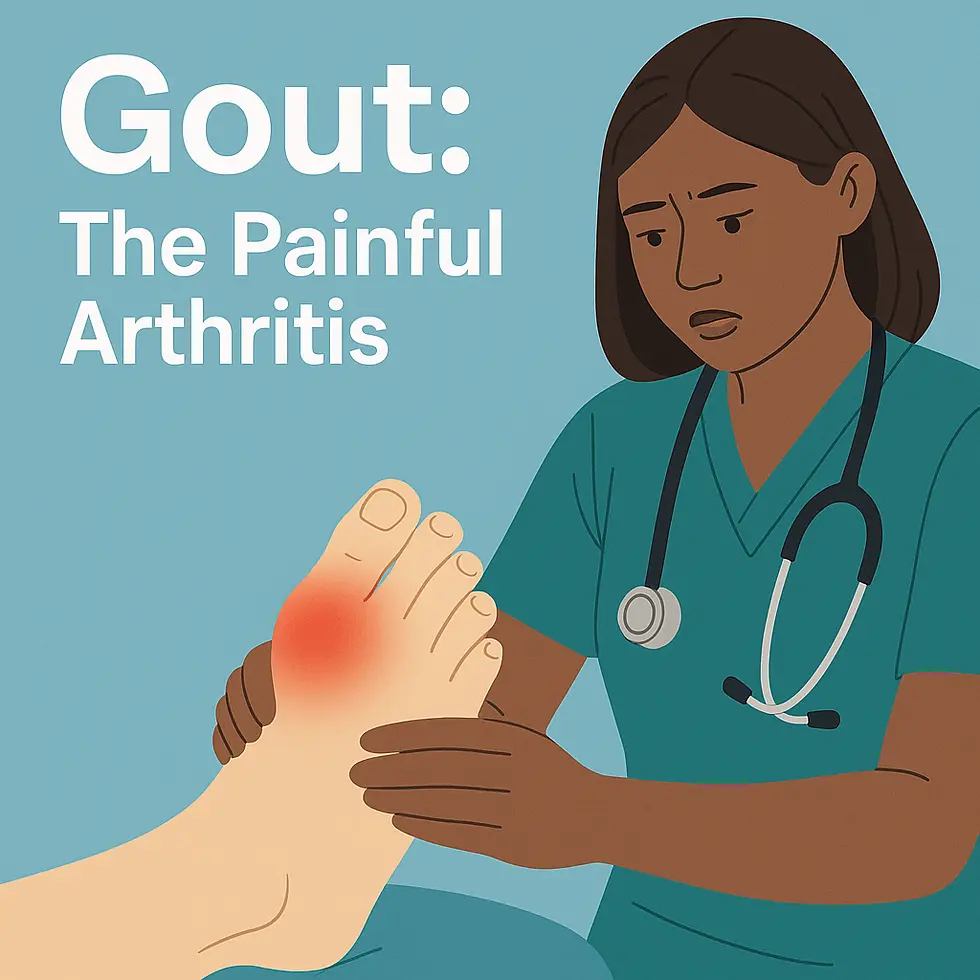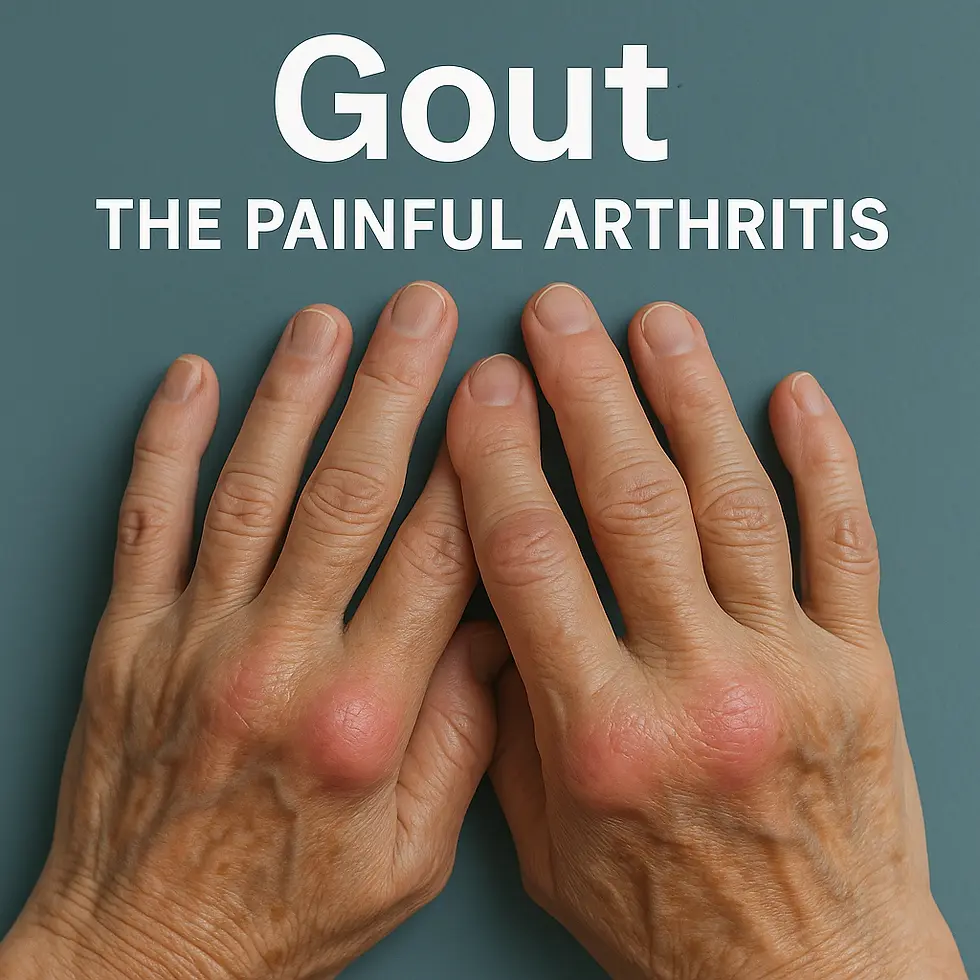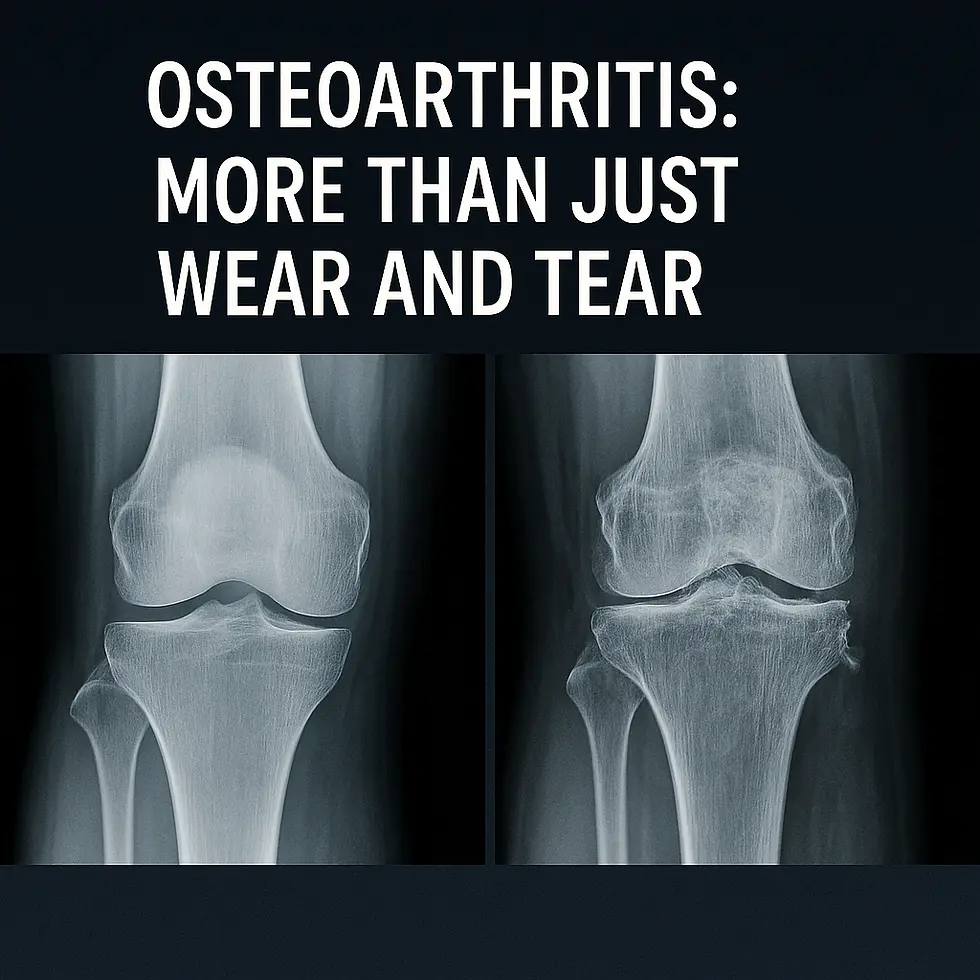Gout and Gouty Arthritis
- Grace. T

- Sep 20
- 4 min read

Gout and Gouty Arthritis: What Nursing Students Need to Know
Introduction
Arthritis is not a single condition, but a group of disorders that cause joint pain, swelling, and reduced mobility. After discussing Rheumatoid Arthritis and Osteoarthritis, we now turn to Gout and Gouty Arthritis, one of the most distinct forms of arthritis. For nursing students, understanding gout’s causes, presentation, and management is essential, as this condition is frequently encountered in hospital and community care settings.
What is Gout?
Gout is caused by the deposition of monosodium urate crystals within joints, resulting from high blood levels of uric acid (hyperuricemia). The classic site of involvement is the first metatarsophalangeal joint (big toe), but it may also affect ankles, knees, wrists, and elbows.
Patients often describe gout as a sudden, severe flare of pain, redness,
swelling, and heat in the affected joint. These attacks are so painful that even the pressure of a bedsheet can feel intolerable.
Risk Factors for Gout
Dietary: High purine intake (red meat, shellfish, organ meats, sugary drinks, alcohol).
Medical conditions: Hypertension, obesity, diabetes, chronic kidney disease.
Medications: Diuretics, aspirin, cyclosporine.
Genetics: Family history significantly increases risk.
Clinical Presentation
Acute, severe joint pain that typically begins overnight.
Rapid swelling, redness, and warmth of the joint.
In chronic cases, tophi may develop—hard uric acid deposits under the skin around joints or ears.
Diagnosis
Joint aspiration is the gold standard: urate crystals appear needle-shaped and negatively birefringent under polarized light.
Birefringent crystals in gout refers to needle-shaped monosodium urate (MSU) crystals that cause the joint pain of gout and exhibit negative birefringence, appearing as yellow when aligned parallel to the axis of a polarizing light microscope's compensator. This optical property, called double refraction, occurs because the molecular architecture of the MSU crystals causes them to refract light at different angles, and observing these yellow crystals is a definitive diagnostic method for gout.

Blood tests: Elevated serum uric acid.
Imaging: In advanced gout, X-rays may reveal “punched-out” erosions in bone.
"Punched-out" erosions with overhanging edges are a classic radiographic sign of chronic tophaceous gout, also known as rat-bite erosions or the Martel sign.

Gout "Punched out" erosion on bone.

Nursing Considerations
Pain management: NSAIDs, colchicine, or corticosteroids are used during acute flares.
Patient education:
Limit alcohol and purine-rich foods.
Stay well-hydrated.
Maintain a healthy body weight.
Long-term management: Adherence to urate-lowering therapy (e.g., allopurinol) is essential.
Monitoring: Assess kidney function, uric acid levels, and watch for complications such as chronic joint damage.
Home Treatment and Self-Care for Gout
While medical treatment is essential, patients can also take steps at home to reduce flares and manage pain:
Ice therapy: Apply a cold pack to the affected joint for 15–20 minutes to reduce swelling and pain.
Rest the joint: Elevate the affected foot/hand and avoid putting pressure on the joint during a flare.
Hydration: Drink plenty of water to help flush uric acid through the kidneys.
Avoid triggers: Limit alcohol, red meat, and sugary drinks.
Weight management: Achieving and maintaining a healthy body weight reduces stress on joints and lowers uric acid levels.
Note for nursing students: Teaching patients simple at-home care strategies improves adherence to long-term treatment and reduces ER visits for acute flares.
Why This Matters for Nursing Students
Gout is one of the most common types of inflammatory arthritis worldwide and its prevalence is rising.
Nurses are often the first to assess and manage acute flares in emergency, inpatient, and primary care settings.
Nursing care directly impacts patient comfort, long-term disease management, and lifestyle modifications that reduce recurrence.

Case Study Scenario for Nursing Students
Case: Mr. D, a 55-year-old male with a history of hypertension and obesity, presents with sudden onset of severe pain and swelling in his right big toe. He reports that the pain began overnight and is so intense that he cannot tolerate wearing a sock. He admits to enjoying beer and steak dinners several times a week.
Questions:
What is the most likely diagnosis?
a) Rheumatoid Arthritis
b) Osteoarthritis
c) Gout
d) Septic Arthritis
What is the gold standard diagnostic test for this condition?
a) Blood uric acid test
b) X-ray of the joint
c) Joint aspiration and microscopy
d) MRI
Which dietary modification should be prioritized for Mr. D?
a) Reduce red meat and alcohol intake
b) Increase high-protein foods
c) Increase sugary drinks for hydration
d) Avoid dairy products
ANSWERS AT BOTTOM OF POST - How did you do?
💡 Ready to Get Certified?
Be prepared. Be confident. Learn First Aid Today & Save a Life Tomorrow with Saving Grace Medical Academy Ltd. Now enrolling: Basic Life Support (BLS) & Standard First Aid CPR-C & AED courses designed for healthcare professionals.
📍 Training for First-Year Nursing Students
Join Saving Grace Medical Academy Ltd. for fully certified, CSA-compliant Standard First Aid CPR-C & AED courses—designed for Alberta’s future healthcare professionals.
Just Remember:
Protect Yourself. Call 911.Don’t Waste Time.
RESOURCES:

Author - Saving Grace Medical Academy Ltd
Grace. T
Medical Content Writer
Answers & Explanations
c) Gout – Classic presentation with overnight onset, severe pain, and involvement of the big toe.
c) Joint aspiration and microscopy – Identifying urate crystals is the gold standard.
a) Reduce red meat and alcohol intake – Both are high in purines, which increase uric acid levels.







